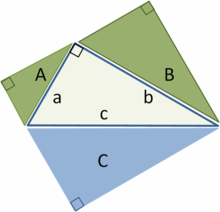Pythagoras for Kids

http://www.historyforkids.org/learn/greeks/science/math/pythagoras.htm
Pythagoras lived in the 500s BC, and was one of the first Greek mathematical thinkers. He spent most of his life in the Greek colonies in Sicily and southern Italy. He had a group of followers (like the later disciples of Jesus) who followed him around and taught other people what he had taught them. The Pythagoreans were known for their pure lives (they didn’t eatbeans, for example, because they thought beans were not pure enough). They wore their hair long, and wore only simple clothing, and went barefoot. Both men and women were Pythagoreans.
Pythagoreans were interested in philosophy, but especially in music and mathematics, two ways of making order out of chaos. Music is noise that makes sense, and mathematics is rules for how the world works.
Pythagoras himself is best known for proving that the Pythagorean Theorem was true. The Sumerians, two thousand years earlier, already knew that it was generally true, and they used it in their measurements, but Pythagoras is said to have proved that it would always be true. We don’t really know whether it was Pythagoras that proved it, because there’s no evidence for it until the time ofEuclid, but that’s the tradition. Some people think that the proof must have been written around the time of Euclid, instead.
Here is the proof:
But how can you know that this is always true, every single time, no matter what size the triangle is?
Take a straight line and divide it into two pieces, and call one piece a and the other piece b, like this:
Now make a square with this line on each side, like this:
and draw in the lines where A meets B on each side to make four smaller shapes. So now you have one square with area AxA (the big yellow one) and one square with area BxB (the little green one) and two rectangles with area AxB (the light blue ones). So the area of the whole square is (A+B) x (A+B) or the area is (AxA) + 2(AxB) + (BxB).
Or you might say that
(A+B)2 = A2 + 2AB + B2
Now draw diagonal lines across the blue rectangles, making four smaller blue triangles. Call those lines C. Do you see that you have made four blue right triangles, whose sides are A, B, and C?
Now imagine that you take these triangles and rearrange them (or if you print it out you can cut them up with scissors and really rearrange them) around the edges of the square like this:
The little triangles take up part of the square. The area of all four triangles together is the same as the two blue rectangles you made them from, so that is 2AB.
The area of the pink square in the middle is CxC or C2.
And the area of the whole big square is, as we have already seen,
A2 + 2AB + B2
So A2 + 2AB + B2 = 2AB + C2
We can subtract 2AB from both sides, so
that gives (ta da!)
A2 + B2 = C2
Here’s an animated short video showing another way to prove the Pythagorean Theorem.